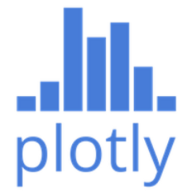

Oracle OBIEE and Plotly Dash Enterprise are competing in the analytics and data visualization category. Plotly Dash Enterprise often has the upper hand due to its modern tech stack and ease of customization, appealing to data-driven organizations.
Features: Oracle OBIEE provides extensive data integration, advanced analytics, and comprehensive reporting capabilities. Plotly Dash Enterprise offers interactive dashboards, real-time graphics, and seamless integration with Python analytics tools. The main difference is Plotly's focus on customization and modern visualization while Oracle emphasizes structured, scalable data reporting for larger enterprises.
Ease of Deployment and Customer Service: Oracle OBIEE requires a complex initial setup and ongoing management needing dedicated IT resources, providing support through traditional channels aligned with enterprise IT models. Plotly Dash Enterprise, with its streamlined cloud-based deployment, offers responsive customer service ensuring a straightforward integration process and faster time to value compared to OBIEE.
Pricing and ROI: Oracle OBIEE involves higher upfront costs and is suited for organizations seeking comprehensive analytics infrastructure with lower cost predictability but significant investment. Plotly Dash Enterprise offers a flexible subscription-based model aligned with modern data-driven needs, providing quicker ROI through agile deployment and customization options, appealing to businesses seeking scalable and adaptable analytics solutions.
| Product | Market Share (%) |
|---|---|
| Oracle OBIEE | 4.5% |
| Plotly Dash Enterprise | 1.5% |
| Other | 94.0% |


| Company Size | Count |
|---|---|
| Small Business | 40 |
| Midsize Enterprise | 34 |
| Large Enterprise | 102 |
Oracle OBIEE (Oracle Business Information Enterprise Edition) is a business intelligence (BI) tool developed by Oracle. OBIEE will gather, store and analyze an organization's network data and compile the information to create reports, dashboard graphs, and performance analysis. OBIEE’s unique platform allows clients to discover new awareness and improve the speed of completing important business decisions by providing robust visual tools and intuitive realization coupled with the latest unmatched enterprise analytics available. OBIEE helps IT enterprise organizations to experience an intelligent view of all enterprise data from across all sources and empowers trusted users with increased levels of reliable, dependable access, interaction, and the ability to utilize the data to increase the overall effectiveness and productivity of the organization.
OBIEE provides unique immediate mobile access, intuitive dashboards, robust reporting, real-time alerts, metadata search, procedure management, direct access to Big Data resources, enlightened in-memory computing, and seamless systems management processes. These features seamlessly combine to make Oracle OBIEE a complete, top-of-the-line broad solution that is cost-effective, minimizes TCO, and provides a competitive, quick ROI for the entire organization.
Oracle OBIEE Top Features
Reviews from Real Users
Sandeep V., Process System Engineer at a comms service provider, tells us, “This solution is very easy for people who are building ad-hoc things. It's an enterprise solution so it can be deployed for a lot of users. There are some great new features that come with the 12c like data visualization, desktop BI Publisher, automation, and interactive dashboards. The product has good features. “
A user who is a CEO at a consultancy relates, “The most valuable feature is the visualization. The data warehousing, data storage, and data wrangling are all features that are in there, and it's one of the better products out there. A good thing is that for large datasets, it's very stable, especially when you have an Oracle database.”
A user who is a Principal Business Intelligence Architect at a computer software company suggests, "It is very biased towards Oracle infrastructure. One of the major red flags we have at the moment against Oracle is that it doesn't support deployment on other cloud providers. We're quite heavily vested in AWS as our infrastructure, and Oracle is yet to formally support deploying on those virtual infrastructure instances. That's quite disappointing, and it also cuts them out of over 70% of the market."
Plotly Dash Enterprise is a commercial platform designed for creating and deploying data visualization applications. It provides advanced tools and infrastructure to simplify the process of building interactive dashboards and analytics applications.
Plotly Dash Enterprise enables professionals to harness the power of Dash framework for enterprise-level scalability and deployment. By integrating seamlessly with existing workflows, it supports easy collaboration while ensuring robust data security. Users appreciate its ability to streamline the development of sophisticated visualizations that can be customized to meet specific analytical needs.
What are the standout features?Plotly Dash Enterprise is employed in finance for real-time analytics dashboards, in healthcare for patient data visualization, and in marketing for customer insights. Its adaptability and ease of integration make it suitable across diverse industry applications where visual data analysis is critical.
We monitor all Reporting reviews to prevent fraudulent reviews and keep review quality high. We do not post reviews by company employees or direct competitors. We validate each review for authenticity via cross-reference with LinkedIn, and personal follow-up with the reviewer when necessary.